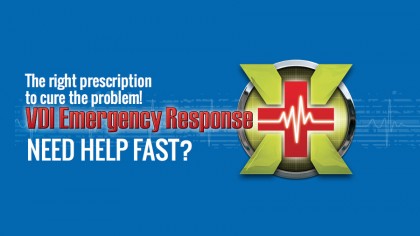Is VDI in need of a health check-up?
X-IO reckons it has the cure

Virtual Desktop Infrastructure (VDI) can help businesses in numerous ways. By deploying thin clients to end users and running desktops on virtual machines, rather than on PCs, they allow organisations to reduce OS management time and complexity and save money by avoiding regular and costly hardware refreshes.
But as a recent blog post by Gartner research director Mark Lockwood notes, organisations deploying VDI for the first time have for many years run into a common set of problems - ranging from inadequate performance from shared storage - to network, CPU and memory bottlenecks.
If VDI is in sick health, Colorado-based X-IO claims to have the cure. The company started out as Seagate's Advanced Storage Division in the 1990s before being spun out as Xiotech and later rebranding to X-IO in 2011.
X-IO is aiming its ISE (Intelligent Storage Element) stoage systems at the VDI market. A hybrid solution, ISE mixes flash and hard disk in a bid to handle random bursts of IO that can be caused by end users concurrently booting up, downloading patches and more.
We spoke to X-IO CEO Brian Owen and Gavin McLaughlin, VP of Worldwide Marketing, at VMworld 2014 to find out more about the potential problems with VDI, what ISE does differently to competing solutions and why vendors' VDI benchmarks may not be telling the whole truth.
TechRadar Pro: Can you fill us in on the company's history?
Gavin McLaughlin: X-IO has been around for quite a while. It was previously known as Xiotech and is an evolution of a technology that was built within Seagate. We looked to create quite an unusual approach to storage that solves some of the fundamental problems of storage hardware based around vibration, heat and keeping drive arrays running for very long periods of time.
Are you a pro? Subscribe to our newsletter
Sign up to the TechRadar Pro newsletter to get all the top news, opinion, features and guidance your business needs to succeed!
TRP: Why would an organisation deploy VDI?
Brian Owen: It goes back to styles of computing. A PC on your desk can be very expensive - you need to pay for maintaining that device as it has spinning disks in it, thumb drives and so on.
The world is moving toward taking that intelligence - the processing that happens on your PC - back to the server to run that same session, but over a network. That gives you a very cheap device on your desktop that can last for seven years rather than three.
The license that you pay for on that desktop for Microsoft and other people is now back on as a service license, and in fact about half of the benefits of implementing VDI is recouping licensing costs. It's also a lot easier to administer because you're doing everything from a server, sending everything back and forth across a network to look like you have a PC on your desktop. There's a lot of cost savings and it's also easier to manage.
TRP: What is the problem with VDI?
GM: There's become some accepted norms in the storage industry which we unseat, for example, that storage hardware needs touching every now and then to maintain, which is something that Seagate wanted to get away from.
We see an accepted norm that when you fill a storage array over 70%, suddenly it starts slowing and you see a performance curve that drops off. Again, how do we eliminate that? Also, how do you keep storage arrays that last a lot longer?
Because of the storage and reliability benefits, we wanted to ask how to make storage that will last six or seven years rather three.
TRP: Was that longevity part of the reason why the IP was acquired from Seagate?
GM: The original plan for Seagate was to take it to market through their OEM channels - so through EMC, NetApp, HP etc. Interestingly, that proposal was actually quite abhorrent to the storage vendor, the reason being that they make money by swapping the kit out every three years. If they don't, they make about 25% of their service revenues from service annuity - particularly when it's four or five years' maintenance.
So to have something that lasted six or seven years and never go wrong was actually detrimental to their business model. They didn't like it, and Seagate realised that they'd invented Frankenstein's monster that was counter-productive to the business.
They spun us off into what was then Xiotech, which for a long time went to market with that as a great intelligent storage array surrounded with controllers that added a lot of features which were in those days needed for storage.
TRP: How has ISE evolved into what it is today?
GM: We realised a couple of years ago that firstly, the storage market was changing. It's not so much about features - if you look at what VMware talks about at VMworld, it's about providing consistent performance and reliability, and a lot of that feature set is moving into the hypervisor. So, whether you call it software-defined storage or not, the world's changing. That means that our product becomes more relevant and we don't need those controller features, so it becomes about the ISE.
We're seeing that, particularly with workloads like VDI, it's becoming more important to use things like flash technologies. A lot of vendors are talking about flash storage, but they usually approach it from the point where you need an all-flash array. Flash can help you, but it's interesting that we see flash as a tool to help us solve problems rather than a solution itself.
We think that there needs to be less talk about the medium and more about the problem and how to solve it. We use a combination of flash and hard disk - in some cases we only need hard disk - to solve the problem. Hard disks can handle some workloads fine.
If you do other operations in VDI, such as recompose, you can get up to around 20,000 to 25,000 IOs per second. You might need something with a little bit more power, which is when things like a boot storm happens and everyone boots at around the same time that you need the 50,000 mark. That's where having a hybrid technology that fuses hard disk and flash together, but as a seamless configuration, can really help you.
TRP: How is X-IO's solution different to competition hybrid storage arrays?
GM: Our technology is different because it works in real time. We don't use caching; we have a lot of intelligence that moves data backwards and forwards between hard disks and flash constantly. So we can soak up bursty workloads, and VDI is a great example, which is why we focused in on that market. For a long time X-IO went to market as a company with some really cool and different technology and asked people what they wanted to do it with. It's hard to make that jump.
You look at the way people buy storage these days and you see solution stacks, so we see two ways of looking at it.

TRP: X-IO offers a 'VDI Emergency Response' program - what is that and where did the idea come from?
GM: We started up something that was a bit tongue in cheek called VDI Emergency Response. Within 24 hours we'll do a triage, and in 72 hours we'll have equipment on-site. It's good because it got us noticed and we also did a lot of themed stuff with doctors' coats, syringe pens, X-IO-themed Red Bull and so on to get people's attention.
We also did an event with Citrix and their consultants in New Orleans which is what gave us the idea. I spoke to one of the lead consultants and asked what got people's attention. He said that many tech professionals enjoy a drink at conferences, which gave us the idea of giving hangover recovey kits to attendees in an Emergency Room-themed booth that's in-line with our Emergency Response Program. Overall, the kits were welcomed by attendees.
TRP: What types of customers is X-IO targeting?
GM: The first is people who have had a problem with VDI, which is where Emergency Response comes in. Then there's people who deploying VDI and don't want to be a guinea pig but don't want to build it themselves, and that's where our X-Pod solution comes in. That gives them a guide and shows them that the VDI's been rubber stamped by people like VM-ware to show that it's genuine and is being delivered using real-world testing tools such as Login VSI.
That's important, because in the storage industry, a lot of the time people use tricks like Iometer, and say that you could fit 2,000 users on a box, so long as they don't actually do anything.
TRP: Does that reflect a wider problem in the industry with less-than-truthful VDI benchmarks?
GM: Vendors lie and cheat, and there's a lot of marketing hype out there where, when you dig into the numbers, you realise that it's not real life. We want people to ask for real-life benchmarks using tools such as LoginVSI that show that load.
We saw one vendor recently say that they could do a price per desktop, but when you looked in the very small print, it said that they were based on the assumption that there was no user data. It's a bit like saying use a Ferrari to go to the shops, so long as you don't buy any shopping. What's the point of it? It's irrelevant.
TRP: Has that led to a distrust around VDI?
GM: I think there's a lot of fear. I've come across some resellers who won't get into the VDI space because they've heard these horror stories. They've heard that storage is particularly painful to sell because of this distrust, which is what we're trying to cut through. If you do it the right way and look at the real world tests, it doesn't have to be painful and can be solved. But there are a lot of people with false numbers.
